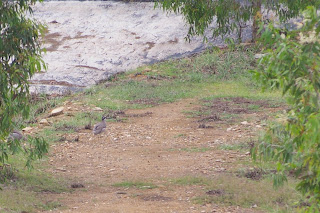A warm morning with high cloud. Destination Julatten. We arrive at our first site at 6.30am. The sun is just touching the tree tops as we walk along the track. Scaly-breasted and Rainbow Lorikeets are feeding on the Melaleuca blooms and a Whistling Kite circles above. Two Dollarbirds recently arrived from Papua New Guinea sit at the top of a dead tree enjoying the morning warmth and Emerald Doves forage along the rainforest margins. Honeyeaters are abundant here and we see Dusky, Yellow, Brown-backed, Graceful, Yellow-spotted and Macleay’s. Macleay’s Honeyeater is found from Cooktown to Paluma and on the Atherton Tablelands. It is Endemic to the Wet Tropics. A Horsfield’s Bronze-cuckoo is sighted and easily identified by the broken breast-bars and the eyebrow.
Moving on to our next site we are surprised by seventeen plus Little Lorikeets, unusual for Julatten. Honeyeaters are also plentiful here. We also see several Pale-headed Rosella. Next stop is Geraghty Park for a quick cup of tea before heading up Mt Lewis. Here we see Little Shrike-thrush, Spectacled Monarch, Pale-yellow Robin, Grey-headed Robin and Red-browed Finch. A small flock of Topknot Pigeon fly overhead and the trees are full of Metallic Starlings.
See the full Julatten list here.
The road up Mt Lewis is still in reasonably good condition making the 10km drive through the rain forest a pleasure. All along the road we see Grey-headed Robin and make a stop to view some Wompoo Fruit-Doves. We arrive at our destination and are welcomed with good views of two Mountain Thornbills.
The air up here is cool and refreshing. Our first sighting along the track is a Grey Fantail. Next we spent a few minutes watching two Bridled Honeyeaters building a nest. We were then lured on by the sound of a Golden Bowerbird calling. Searching off the track we found a male Victoria’s Riflebird and a Spotted Catbird. We also found the display court of a Tooth-billed Bowerbird. This was about two metres in diameter and cleared of everything excepting several fresh native ginger leaves placed shiny side down. We never did find the Golden Bowerbird.
Back on the path we saw Fernwren, Yellow-throated Scrub-wren and Large-billed Scrub-wren. We had several good sightings of Bower’s Shrike-thrush in full song.
The first group of Chowchilla were found just before reaching the dam. They were being carefully watched by a Rufous Fantail and Spectacled Monarch as they busily scratched through the leaf litter. These would quickly dart in and grab any stray morsel missed by the Chowchilla.
At the dam we spotted a Water Dragon sunning on its customary log. The resident Platypus was unfortunately nowhere to be seen. Two more groups of Chowchilla were seen on the return trip to the vehicle.
Full Mt Lewis list here.
After a cup of tea we drove down to the Julatten Barramundi farm to round off the morning with some Pacific Black Duck, Hardhead, Ibis and a Little Pied Cormorant.










